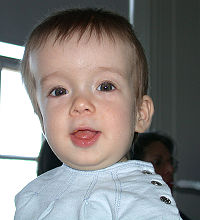
Photo from wikipedia
Abstract The dysplastic maxilla and retracted zygoma characterize Apert’s syndrome. The relationship between the cranial base and facial development is believed to be influential and substantial. The purpose of this… Click to show full abstract
Abstract The dysplastic maxilla and retracted zygoma characterize Apert’s syndrome. The relationship between the cranial base and facial development is believed to be influential and substantial. The purpose of this study is to explore the temporal relationships of maldevelopment of these structures to identify potential influence patterns. Fifty-four CT scans (unoperated Apert’s, n = 18; control, n = 36) were included and divided into three age subgroups (0–6 months, 6 months–2 years, and 2–6 years). All measurements were analyzed by Materialize software. Cephalometrics relating to midface and cranial base were collected. In anteroposterior direction, prior to 6 months, the zygoma was markedly retruded by 12% in Apert’s, followed by persistent retrusive shape into adulthood, averaging 17% shorter compared to controls. The maxillary anteroposterior dimension was 22% shorter than normal before 6 months of age, thereafter, it maintained at least an 18% deficiency into adulthood. In the horizontal direction, the transverse width of the zygoma increased 39% between 6 months and 2 years of age, and it was 14% wider on average overall into adulthood. The maxilla had normal growth in transverse and vertical directions. The zygoma is the most severely deformed anatomic facial structure in early infancy, in both positional relation and geometric shape in Apert’s syndrome. This may develop as a ‘bridge’, influencing the structure, transmitting malformation stresses, caused by premature fused coronal and peri-zygomatic sutures, into facial structures and the maxilla.
Journal Title: Journal of Plastic Surgery and Hand Surgery
Year Published: 2019
Link to full text (if available)
Share on Social Media: Sign Up to like & get
recommendations!